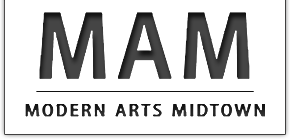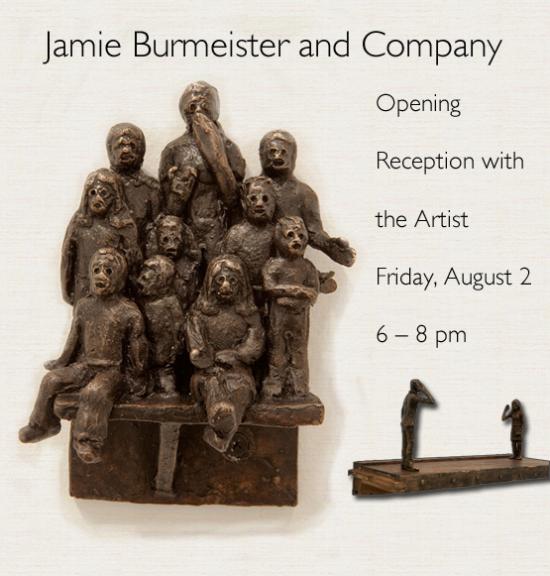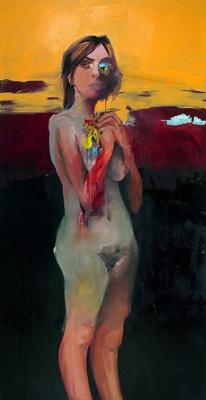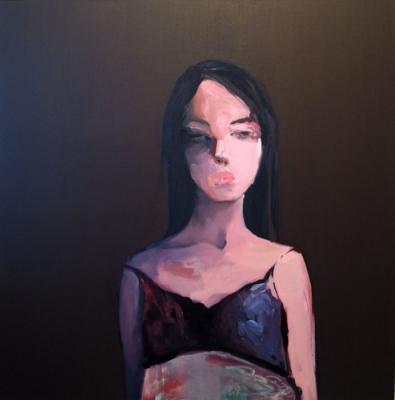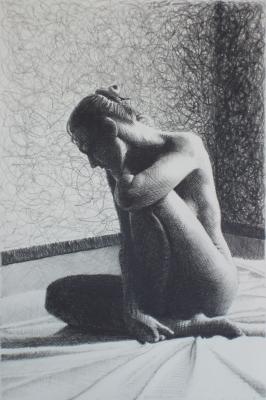Also Featuring Byron Anway, Theresa Pfarr, Gerard Pefung, John Spence, Richard Chung, Charles Novich, Troy Muller, Tom Rierden, Todd Brown, Tim Guthrie, and Justin Meyers.
About the exhibition: MAM’s summer series ends on unpredictable note
-by Michael J. Krainak, Free Lance Writer in the Visual Arts
The summer trifecta of exhibits at Modern Arts Midtown ends in August with Jamie Burmeister and Company, the polar opposite in tone and content of June’s The Challenge of Fun. The “Company” in this show refers not only to Burmeister’s ongoing sculptural project in miniature, “vermin.me,” but to artists who concentrate on figurative work including Charles Novich, Theresa Pfarr, Richard Chung, Alex Borovski, Byron Anway, Gerard Pefung and Tim Guthrie, among others.
The “challenge” for the viewer in August’s exhibit is to appreciate the variety and nuance a group of artists brings to such traditional genre as the figure and portraiture, no matter what medium from oil and watercolor to clay and bronze. In the spotlight is Burmeister’s densely populated installation of “vermin,” his name for 4-inch sculptures of human figures engaged in a variety of ordinary activities and displayed in large groupings or in hidden corners of galleries. Add to these pieces Chung’s equally quixotic everyman sculptures or the darkly moody scenarios of Novich and portraits by Pfarr, and the show depicts a mirror image of society at work, play or leisure. We are in good but complex company because we identify with the same hopes and desires, conflicts and anxieties of what it means to be human.
Dominating the exhibit of course is the titled Burmeister installation of large size sculptures occupied by groups of his signature vermin. Rather than just his traditional ceramic pieces, these vermin are bronze, and in a moment of inspiration, Burmeister has arranged them to appear to be creating the larger modernist works, three in all. In addition, about 1,000 other ceramic vermin are scattered throughout MAM as well. Though the artist has a well-deserved reputation regarding his popular Rube Goldberg-like interactive machines, he says, “My approach is the same for all my work. I am always interested in context and the space my work occupies.”
In fact, it can be said that as exotic and fantastic as his kinetic sculpture and little people are, they connect Burmeister to the real world much as his more traditional work. “Through my art, I have come to realize that I can only understand myself,” he said. “My work deals with my conscious experience of the world.”
Which might explain his decision in this show to have his vermin be his mediators, his alter ego. Whereas, in many other installations, the small figures often appear to be lost or lost in thought, wandering or just hanging out, here the vermin are working together, creatively, for a common purpose. Perhaps Burmeister has had an epiphany about his connection as an artist, although there are still plenty of his wonderfully expressive little critters about in order to remind us not only of his quirky POV and sense of humor, but that there are yet a lot of folks who haven’t joined the congregation or made their mark.
In contrast to Burmeister’s more personal work, we have the sculptural figures of Chung that represent a broader interpretation of the human condition. His largely realistic, unflattering portraits interpret such qualities of the human experience as free will and fatalism, power and weakness, wisdom and ignorance. Chung says, much like his edgy pieces here, “I tend to find myself in a state of flux, searching for the boundaries of banality and transcendence.”
The expressionistic portraits of Pfarr also explore the darker side of the human condition but with a narrower social conscience. Motivated by her research of the narratives and conventions of advertising and the fashion industry, she offers unflattering and unflinching images of models that have long ago lost their innocence but continue to pose in various stages of burnout.
Anway’s more realistic portrayal of the common man and woman conversely show little of the psychological precipice that Pfarr’s figures perch upon. Instead, except for an introspective self-portrait or two, Anway’s figures seem comfortable in their own skins or at least accepting of their lots in life. You may not know these people by name but you’ve seen them every day of your life.
Except for the occasional moody and ultra-realistic scenarios of Novich, he brings to both his nudes and landscapes a quiet contemplation that are all about composition, nuance, texture and form. In contrast to Novich’s precise studies of the human figure, the streetwise urban portraits of Pefung reveal his Cameroon roots in the art of the mask as well as an identification with graffiti art. Of all the portraiture in this exhibit his are the most bold and celebratory.
With much of art exhibited during this three-part summer series the result of new or part of a developing series or exploration, MAM owner Larry Roots is confident that the spotlight has been on the artist themselves. “Much like a museum, we can bring older work forward to compliment new work within a different and ongoing continuum,” Roots said. “The emphasis is on the artist’s evolving career and process while keeping the art from becoming mere merchandise."
